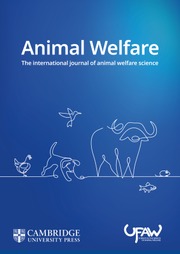Article contents
Assessment of unconsciousness during slaughter without stunning in lambs
Published online by Cambridge University Press: 01 January 2023
Abstract
The aim of this study was to assess brain activity in lambs during slaughter without stunning and its correlation with heart rate (HR) and the absence of physiological reflexes. The index of consciousness (IoC-view®) assesses consciousness by an algorithm that analyses the EEG and gives an index from 0 (unconscious) to 100 (conscious). Eight lambs (Merino breed) of 20 to 25 kg live weight were individually restrained in a stretcher and three skin electrodes were placed at the level of the frontal bone. The electrodes were connected to the IoC-view®. Two additional electrodes were placed on the chest and the HR was transferred to a watch monitor. Recording time started 2 min prior to sticking to attain the basal IoC and HR value of each animal. During bleeding, presence of corneal reflex and rhythmic breathing were recorded every 10 s until brain death. Rhythmic breathing disappeared at an average time of 44 (± 4.2) s after sticking, ranging between 30 and 60 s. The corneal reflex disappeared at 116 (± 11.01) s, ranging between 80 and 160 s after sticking. Changes in the brain activity occurred between 22 to 82 s after sticking (52 [± 20.2] s). In five out of six animals the HR increased (177 [± 22.7] beats min−1) compared to basal values (139 [± 8.4] beats min−1) at 115 (± 97.5) s after sticking. Both brain activity and physiological reflexes revealed that when bleeding is performed, through a transverse incision across the neck without stunning, the onset of unconsciousness could last 1 min which impaired animal welfare. This prolonged consciousness compared to other authors’ findings may be attributable to inefficient bleeding when lambs are slaughtered without head restraint.
Information
- Type
- Papers
- Information
- Copyright
- © 2012 Universities Federation for Animal Welfare
References
- 15
- Cited by

